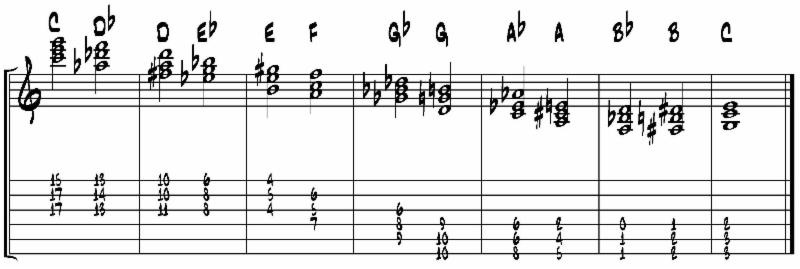|
by Scott Hesse  Often times simplicity is best in music, as in life. So I thought for this week's tip, I'd go back to something fairly simple...then expand it. After all, I do like some complexity mixed in too! This exercise is designed to help make your playing more colorful by utilizing the extensions of a chord (9, 11, and 13). In doing so, you will hear immediate results as you add this on top of what you already know how to play. What you see below, in Example #1, are seven different groups of notes that can be played over an F7 chord. They are arranged in four-note cells and ascend diatonically. The cells themselves are also put together positionally on the guitar. For example, Group 1 starts in first position and includes four notes you can play from the mixolydian scale on the B and high-E strings. The rest of the groups follow the same basic intervallic pattern as they ascend by position and through the scale. Example: Each group is played only on the B and E-strings. When you play all the groups in succession, the result is a colorful and modern way to approach this particular chord.
Remember, too, that these notes that work over an F7 chord will also work well over Am7(b5), Cm7, and EbMaj7(#11). So, the main idea is to stay simple here. Use only the top two strings of the guitar. I find that these little cells are great to use as foundation melodies when improvising. As you progress up the neck, each cell includes at least one extended chord tone. You have the choice to use the entire exercise as a larger melodic sequence by moving from position to position, or you can isolate one or two of the cells. It's up to you to use as much or as little of the cells as you like. Happy practicing!!
0 Comments
by Scott Hesse  The process of training your ear for harmony is ongoing. Sometimes in order to hear more, you have to practice an idea from every angle. That's the idea with the progression below. It's based on a minor 2nd chord cycle, but a little different than the one we looked at before. This time the cycle doesn't include the V-I relationship and just ascends chromatically. The twist in how this is accomplished, however, is the voice leading. The chord voicings actually start very high on the fretboard and descend in range. At the same time, the key centers actually ascend chromatically. This gives a bit of implied counter point to the progression. Moving the harmonies in this fashion can be difficult because they seem to progress against your ear's expectation. That's a good reason to practice this: it will train you to hear differently, or in a more expanded way. When you improvise or compose, your ability to hear from any direction allows you to be freer with your expression. The exercise above is just one of many ways to break down this or any other chord progression. Experiment as much as possible and find ways that catch your ear. Remember, any of these chord cycles can be used as substitutes for other standard changes.
If you have questions or comments, please post below. Happy practicing!! |
Guitar NotesHey, Friend! Welcome to Guitar Notes, practice tips and exercises for the progressing guitarist. I am passionate about music and all the possibilities for growth that come with an in-depth study of music. Even more, I am committed to sharing what I know to help YOU find a deeper awareness of your own possibilities as a musician. Here you will find a growing archive of the tips I send by email every other week. (Click the link below to sign up.) Archives
January 2016
|


 RSS Feed
RSS Feed